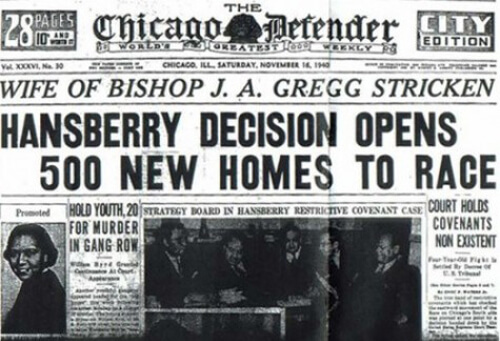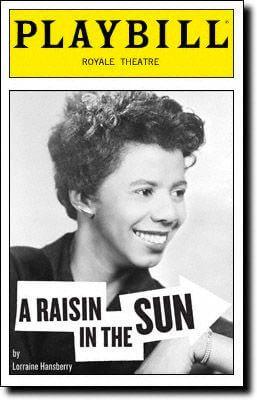Lorraine Hansberry (1930–1965)
Playwright Lorraine Hansberry’s A Raisin in the Sun was the first drama by an African American woman to be produced on Broadway. Widely acclaimed, it helped pave the way for other black playwrights. She completed only two plays in her short life, but left unfinished works that published posthumously, extended her contribution to literature, theater, and the Civil Rights Movement.
Hansberry was born May 19, 1930, in Chicago, Illinois, the youngest of four children. Her mother, Nannie Perry, was a schoolteacher active in the Republican Party. Her father, Carl Augustus Hansberry, was a successful real estate entrepreneur involved with the National Association for the Advancement of Colored People (NAACP) and the Urban League.
When Hansberry was eight years old, the family moved into a primarily white neighborhood with restrictive covenants preventing African Americans from buying homes. Hansberry’s father challenged the restrictions, and the U.S. Supreme Court ruled in his favor in 1940. Racial discrimination in Chicago, however, remained harsh and brutal. Hansberry’s experiences in desegregated public schools and in a self-described “hellishly hostile white neighborhood” influenced her best-known play.
After graduating from Englewood High School in 1948, Hansberry attended the University of Wisconsin, furthering her interest in theater and becoming involved with the Young Progressives of America. In 1950, she left college for New York City where she studied at the New School for Social Research, and became a staff writer and eventual editor for Paul Robeson’s progressive black newspaper Freedom.
As a reporter, Hansberry traveled widely, even attending the 1952 Intercontinental Peace Conference in Uruguay, and wrote about subjects ranging from social inequalities to the arts. She taught classes at Harlem’sFrederick Douglass School and was consistently active in politics. In 1951, Hansberry met Robert Nemiroff, a white graduate student and songwriter, at a New York University antidiscrimination rally. They married June 20, 1953.
Hansberry worked several jobs until 1956 when she began writing full time. She finished A Raisin in the Sun in 1957, taking its title from the lines of a Langston Hughes poem: “What happens to a dream deferred?/Does it dry up like a raisin in the sun?” The play portrays the realistic struggles of a working-class African American family wanting to improve their lives.
A huge critical and popular success, A Raisin in the Sun opened at Broadway’s Ethel Barrymore Theatre on March 11, 1959, running for 350 performances over 19 months. Hansberry became the first black woman to have a play produced on Broadway and the youngest person and first African American to win the New York Drama Critics Circle Award for Best American Play. Variety named her the season’s “most promising playwright.” Writer James Baldwin later wrote: “Never before, in the entire history of the American theater, had so much of the truth of black people’s lives been seen on the stage.”
A Raisin in the Sun has been widely performed and anthologized, and The National Theater lists it among the 20th century’s 100 most significant works. Hansberry wrote the screenplay for the 1961 film adaptation, winning a Cannes Film Festival Award and a nomination for a Screen Writers Guild Award. Her initial draft, with material not included in the 1961 movie, was published in the early 1990s. In 1973, the play was adapted into a musical, Raisin, which won a Tony Award and ran for nearly three years. In 1960, NBC commissioned Hansberry to write a TV drama for the Civil War centennial, but her examination of slavery was controversial and the project was cancelled. The material was posthumously published as the play The Drinking Gourd.
Nemiroff and Hansberry moved from New York City’s Greenwich Village to Croton-on-Hudson in 1961 where Hansberry lived until her death. During this time, she generated support for the Student Non-Violent Coördination Committee (SNCC), which aimed to end segregation in the south, and spoke out against the House Un-American Activities Committee. In 1963, Hansberry joined prominent civil rights leaders to meet with Attorney General Robert Kennedy. That year, the Actors Studio Writers Workshop staged a scene from Les Blancs, her play about Africa.
Hansberry was diagnosed with cancer in 1963, but she continued to write and participate in political causes. In 1964, she wrote the SNCC book The Movement: Documentary of a Struggle for Equality. That May, she was released from the hospital to address United Negro College Fund writing contest winners. In this speech, she used the phrase “to be young, gifted, and black,” which later became the title of a play and book about her.
Also in 1964, Hansberry and Nemiroff divorced, though they remained close. He helped produce The Sign in Sidney Brustein’s Window—the only other completed work produced in Hansberry’s lifetime—which opened at Broadway’s Longacre Theater to mixed reviews. The play concerns a liberal intellectual’s experiences with politics and activism; it closed January 12, 1965, the day Hansberry died of pancreatic cancer at age 34. Her early death was mourned in many circles, and more than 600 people attended her funeral where tributes from government, arts, and civil rights leaders accompanied Robeson’s eulogy.
As executor of Hansberry’s literary estate, Nemiroff extended her work’s influence. He collected and adapted unfinished pieces, letters, and diary entries into a play, To Be Young, Gifted, and Black. Produced in 1968, it became the longest-running off-Broadway play of that season, and was later published as a book entitled To Be Young, Gifted, and Black: Lorraine Hansberry in Her Own Words. He also finished Les Blancs and published it with the plays The Drinking Gourd and What Use Are Flowers? Hansberry is celebrated for giving realistic dramatic voice to African American characters and concerns. The Lorraine Hansberry Theatre was incorporated in San Francisco in 1981.
Source: http://blackhistorynow.com/lorraine-hansberry/


